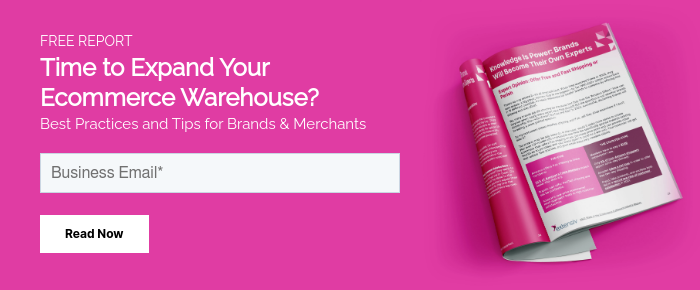You ever hear the saying “traffic is king”?
We didn’t either, until Amazon banned incentivized reviews tied to Amazon sellers giving away free or heavily discounted products in exchange for reviews (which increased artificially increased traffic and sell-through velocity on your Amazon product listings).
Now there is a new king in town, and that’s Amazon’s Sponsored Ad platform, which can drive significant traffic to your Amazon listings.
At first glance of Amazon Sponsored Ads seemed intimidating, but the traffic benefits to your Amazon product listings are insane. As we said in this blog post, we’re now entering a pay-to-play Amazon environment in 2017 - you gotta pay, to make money on Amazon and that money is going back into Amazon’s pocket :)
Here’s proof of what one of our Extensiv Order Maanger clients shared with us and what Sponsored Ads can do for you:

This Amazon seller generated $200,000 on spend of $35,0000 - meaning, for every $1 of sales generated, Amazon is getting roughly 17 cents. That’s a great deal, and will change depending on what category you sell in.
Let’s now get to gold nuggets of our guide —creating an Amazon Sponsored Ad campaign that works, drives traffic and most importantly, is profitable. Even if you're already using Amazon PPC to drive traffic and sales, you can benefit from some of these tips to increase relevance, find new keywords, and lower your ACOS.
We’re going to show you how this is done. Look no further: This is the ultimate guide to creating a high performing Amazon Sponsored Ad Campaign.
The Basics: Why Use Amazon Sponsored Product Ads?
Amazon's sponsored product ad platform is a tremendously powerful tool for Amazon sellers that is surprisingly underutilized, even by large Amazon retailers.
Despite that, it is a tool that you can use to increase your traffic and sales with only a small investment, while reaping other benefits that will in turn add value to your entire campaign.
Amazon also offers tracking metrics that you can use to keep your campaigns profitable or just break-even, no matter what your goals.
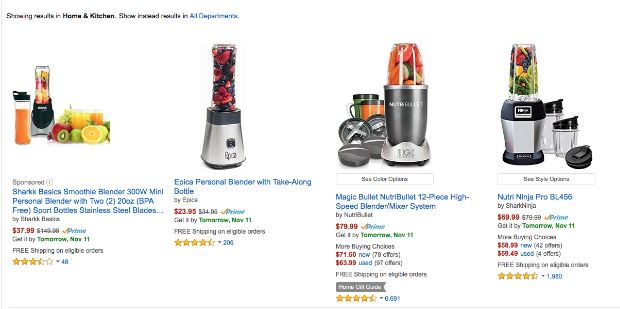
(Amazon's sponsored product blends almost seamlessly with regular products, and has a high chance of getting the customer's click)
Unlike Google Ads for Amazon, Amazon Sponsored Products is simple to use, designed for the amateur rather than the professional marketer, and designed around selling products on Amazon. Sellers can also benefit in myriad ways.
Amazon Sponsored Ads allows you to increase traffic to your product listing, which inevitably will increases sales, which ultimately increase your Amazon Best Seller Rank, and increases your organic visibility and your organic sales. BOOM!
For small sellers just getting started on Amazon, they buy all this inventory only to find that their niche has a large amount of competition, and they are having trouble ranking their new products. Luckily for larger sellers and sellers with more experience (and capital), Amazon PPC allows you to pay for that increased ranking, so you get more exposure, and start driving traffic and sales right to your product pages.
Ponder this: Only 30% of Amazon shoppers make it past the first page or inversely, 70% of Amazon shoppers only purchase product from the first page.
So if you’re in a crowded category on Amazon, you need to pay to get traction and exposure. Look at this example: Our search for Blenders on Amazon, we could see that Blenders have thousands of options in most categories.
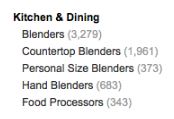
And while that might seem intimidating, Blenders are actually a low competition niche. If you were to choose something like a phone case, you'd be looking at millions of competitors.
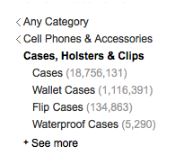
Amazon sponsored ads allow you to take control and ensure that you get exposure, traffic and therefore sales, for your Amazon product listings.
Serious Benefits of Amazon Sponsored Product Ads
Here’s the rub: Amazon's PPC platform allows you to set up automatic product ads, which allows you to quantify your exposure, optimize your listing by checking the click through rate and sale rate by keyword, and even find new keywords.
You don’t pay for impressions, only when someone clicks on the Sponsored ad, which allows you to judge conversion rates, quality of the ad, and the relevance of your product to the keyword.
Importantly, you shouldn't use Amazon PPC unless you have well written and highly detailed product pages that are already optimized for conversion. You should also plan to keep optimizing your listing as you get more traffic and more data so that you can increase your conversion rate and lower your costs.
If you see Amazon customers searching for a product keyword and it’s getting a ton of impressions, make sure you include that in your title, features, description and the keyword back-end of Amazon Seller Central.
Using Amazon PPC

Setting up an Amazon PPC campaign should involve split testing, experimentation, and using multiple tools to find results and compare them. Amazon offers two basic options for sponsoring products and these include manual and automatic. Each of these has its own advantages and disadvantages.

Automatic Targeting – Automatic campaigns are available for sellers with a Professional seller account ($39.99 per month) and allow you to set your maximum bid and then hand Amazon the control to show your ads to keywords and phrases that they think are relevant. This can be extremely valuable for researching keywords, seeing what people are actually searching and clicking on, and testing the keywords you have in your listing. Amazon pulls keywords from your category, related listings, and the keywords in your product listing. However, you get much less control and cannot control which keywords you are bidding on or the bid level. You can, however, add negative keywords to prevent Amazon from using a keyword that costs you money.
Manual Targeting– Manual campaigns allow you to set up individual keywords which you can research and test yourself, and then run them with group or keyword level bids set for each keyword. This offers you more control but can be risky if you haven't put enough time into your keyword research. For best results, split your campaign up with exact, phrase, and broad match keywords, and then use that to see what people are actually searching for so that you can optimize over time. You can add up to 1,000 keywords per manual campaign.
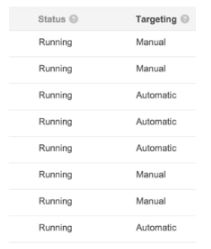
(Running both manual and automatic campaigns at once allows you to control spend on high performing keywords while researching and collecting data with auto campaigns.)
Tips:
- Use both automatic and manual campaigns
- Use automatic campaigns to handle keyword research and to experiment with new ideas.
- Start out with a low budget and then increase your daily spend as you optimize your campaign and increase your conversion rate.
- $5 a day is a good minimum after you have optimized everything. However, if you do have a decent ACOS for the keyword, a daily limit may simply be limiting your sales.
- Sales in seller central can be delayed by 48 hours or more. For this reason, you should always edit the view by date to exclude the previous three days to ensure that you are seeing an accurate view of sales.
Choosing Products
Ideally, you should split campaigns up by product for simplicity. While this can be a hassle if you have a great deal of products, smaller e-commerce sellers can greatly benefit from it. If you do have a lot of similar products, a single ad group is fine, but it is more difficult to track.
Your primary goal is to choose products that are highly relevant to your keywords. You should also split up campaigns by where you got keywords from. Create specific campaigns for high performing keywords.
Keyword Types
You can choose up to three types of keywords when setting up your Amazon PPC.
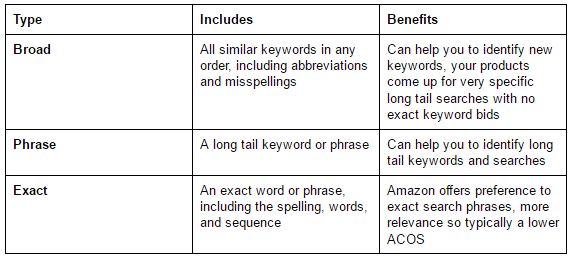
How to Use Advertising Cost of Sale or ACOS
In most cases you should use all three so that you can continue to experiment and optimize your campaigns over time. While you will likely make more sales with exact match, broad and phrase allow you to research keywords to see what people are searching for so that you can add more specific and relevant keywords to your exact match campaign over time.
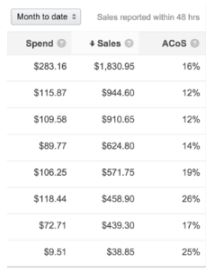
ACOS is the percent of sales spent on advertising. This number makes it easy to calculate whether your ads are profitable or not.
How to calculate your ACOS:
Retail Price – FBA Fees – Total Cost of Goods (Including Shipping, Handling, Packaging, etc.) = Profit Per Unit.
Example: Retail Price $22 - FBA Fees $11 – Cost of Goods $5 = Profit $6
In this case, your profit margin is 27%, which you can use to calculate that you cannot go over 27% ACOS without losing money on your product.
Of course, you do want to earn money not just break even, but you can consider that your Amazon PPC campaign will earn you money in other ways. For that reason, you can aim to break even for the first few months while you build up your sales velocity and increase organic sales.
Amazon shows you ACOS at campaign, ad group, and keyword level, so you can calculate the total profitability of each.
What's a good ACOS? That entirely depends on your campaign, your profit per item, and your goals. Normal ACOS can range from 2% to over 50%, and can be profitable. However, you should calculate in your maximum budget so that you can understand when you're spending too much so you can reduce keywords.
Conversion Rate
You can use your average conversion rate to calculate profitability per campaign. For example, if you're bidding $1 per click and pay an average of .80 cents, then you can calculate that at a 10% conversion rate, you would be spending an average of $8 per sale, which would be a loss at $6 profit. You would have to either increase the conversion rate or decrease your bid to see a profit or to break even. In this case, you would have to bid a maximum of 60 cents per click or increase your conversion rate to 13.4% or higher to see a profit.
Things won't always be quite so clear cut because your conversion rate will change and the amount you pay per click might vary quite a bit. However, you can calculate averages and use them with a safety margin to ensure that you don't start losing money.
Tip: Track the value of your keyword research and your increase in organic sales. If you've been running your PPC campaign for a month and your organic sales go up by 40%, you can actually afford to run your PPC at a slight loss to maintain that sales velocity and organic ranking.
Using the Search Term Report to Optimize Your Campaign and your Amazon Listings

The Search Term Report allows you to check to see what people are searching for when they find your ads. This is a powerful tool that you can use to refine and add to your own keywords. Download your search term report at least every 60 days, or you will lose the data.
- Import the search term report into Excel
- Use Excel filters or scroll through to look at your data
- Ignore anything with only 1-4 clicks, as this could skew your total results. Similarly, ignore anything with a click through rate lower than .5
- Choose keywords that have high sales rates per click through and a low ACOS rate.
- Add these keywords to a manual campaign. This will allow you to control your bids and daily budget for it and get more clicks.
- Run your highest performing keywords through a keyword tool to get new keyword ideas.
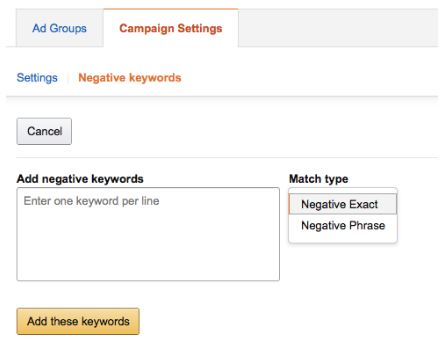
- Go through your results and look for very low performing keywords. Those that are consistently costing you money (High ACOS) or have a very low click through rate should be added to your negative keywords so that Amazon won't bid on them in your automatic campaigns.
- Don’t worry about having the same keywords in multiple campaigns. Amazon won't bid your own campaigns against each other.
Take the time to review your keywords, relevance, click through rate, and all other metrics. - Update your product listing keywords based on high performing keywords and remove any low performing ones from the page.
Optimizing Manual Campaigns
Manual campaigns are easy to optimize because you can simply reduce the bid or pause low performing keywords. While you do want to wait at least three weeks before you remove a keyword, you can typically tell if the ACOS is too high for you, the conversion rate is very low, or the keyword is not performing in less than 90 days. Reducing the bid will reduce your impressions and clicks, but will reduce the cost per sale. Pausing the keyword will only pause the keyword. A common myth says that Amazon will dissassociate your product from the keyword if you pause it, but this isn't true.
You should try to review your manual campaign data at least once a month to ensure that your keywords are performing well, and more frequently when optimizing your campaign. However, Amazon sales only update after three days, so you will have to choose a view date for sales that doesn't include the previous three days to see accurate data.
Manual Campaigns Suggested Bids
Although you have the ability to change your bid as much as you please sometimes you struggle to figure out where to start with your bids, or maybe you’re curious what your competitors are bidding on certain keywords. Luckily, Amazon has “Suggested Bids” next to every keyword you input. Once the keyword has had time to register (usually a day or so) a suggested big will appear next to it. This is the bid Amazon suggests you use if you want to win the big for the specific keyword. Usually this will be slightly higher or equal to your competitors bids. With simple click of an “Apply” button, you can immediately raise or lower your bid to the suggested price.
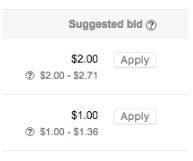
Using Competitors and Brand Names
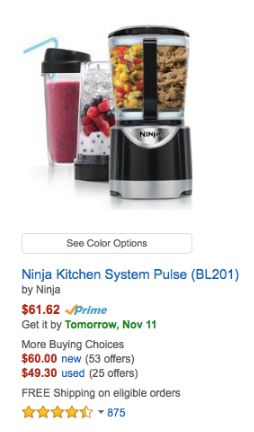
(If you were selling blenders, you couldn't use "Ninja" as a keyword, but you could use "Kitchen System" and "Pulse" as keywords, because buyers looking for those products will likely use those words – However, you don't want to get too specific with product competition, if someone is looking up a specific product, they might only want that product)
Amazon discourages using competitor brand names as a keyword, but that doesn't mean you can't use a competitor keyword analysis to add to your own keywords. Simply reviewing your competitor products will give you a good idea of which words and names they use, and what someone might type into a search bar when looking for them. For example, many products actually have misspellings of products as their name, and you can use these misspellings without raising any red flags for Amazon. You can also use tools like Yoshikoder to see how often specific words show up on their page to see what keywords they are using.
Keyword Research Tools:
- Google Keyword Planner
- Bing Keyword Planner
- Moz Keyword Research
- Sonar Tool (SOLID)
- UberSuggest
- LSI Graph
- Keyword tool dominator
Conclusion
Amazon PPC offers a lot of value to e-commerce sellers, simply because it allows you to generate sales, boost your sales velocity and therefore your Amazon ranking, and collect data on one budget.
By running multiple PPC campaigns using automatic and manual types, checking your keywords and what people are clicking on, and refining and optimizing over time, you can continue to generate new Amazon sales and new keywords to improve the quality of your PPC over time.
This isn’t fluff—this is Amazon PPC stuff works for massive Amazon Sellers. And it will work for you too.
If you do it right, Sponsored Ads can become a big driving factor to your Amazon product listings and compensate for the loss of Amazon incentivized reviews.
Stay at it, as it takes consistent work to get your Sponsored Ad campaigns to be high performing. You can’t stop for 1-day, as your aCOS can change and your competitors may crowd around your keywords.
Amazon also makes it easy to refine by allowing you to check what people are actually clicking on, allowing you to use negative keywords to remove costly words from automatic campaigns, and making it easy to research individual niches.
Roll up your sleeves, keep putting in the hard work, and you’ll see your Amazon traffic, sales and best selling rank soar.
What are your favorite tips and hacks for creating a high performing Amazon Sponsored Ad campaign?
